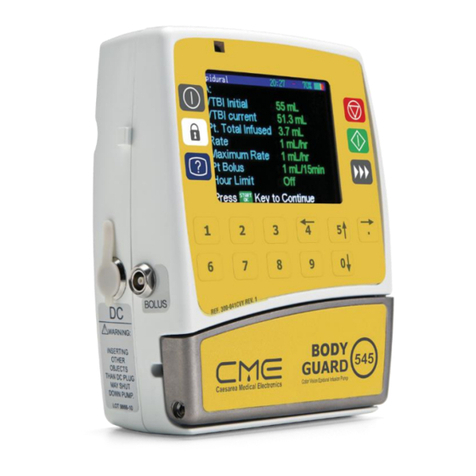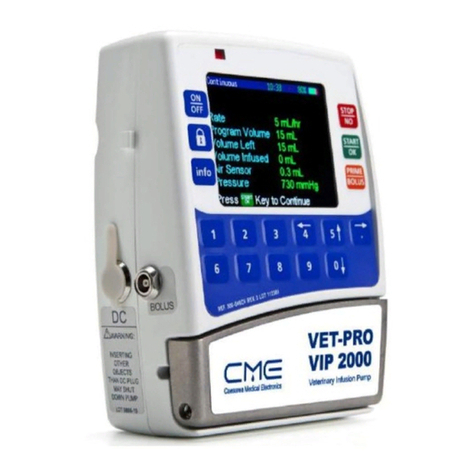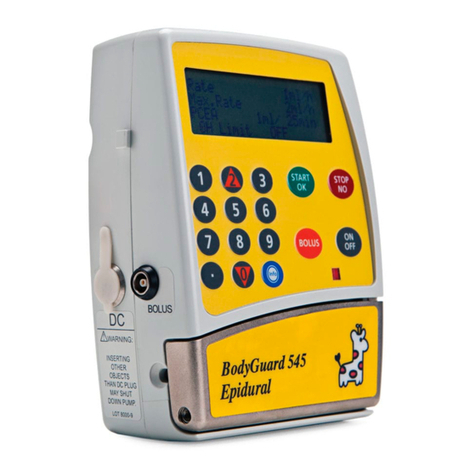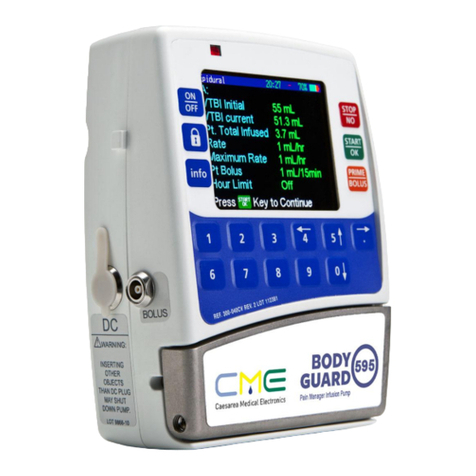
Software ver. CVPCA30E_1 9
System Safety Checks
The following details outline the safety checks designed into the BodyGuard®
pump to minimize the possibility of under or over infusions.
Free Flow Protection
When the set is installed in the pump and the door close two ridges on the door
clamp the set so only the movement of the motor pistons can allow fluid to
pass. With the door open protection is afforded by a check valve, present in all
BodyGuard® sets, that prevents free flow towards the patient when the set is
not attached to the pump. When the pump is attached to the set and delivering
fluid, the pressure delivered by the pump opens the valve. The check valve also
prevents reflux. The design of the check valve means that although a pressure
of 2-3psi can open the check valve in the direction of the patient reflux cannot
occur regardless of the pressure that builds up in the set.
Post Occlusion Bolus Reduction System
During an occlusion, pressure in the downstream section of the line can build
up to 10psi (depending on user defined settings). When the pump alarms the
user will check the line and attempt to clear the occlusion. In the absence of
Post Occlusion Bolus Reduction System the pressure build up could cause a
surge of fluid into the patient. This feature works by reversing the operation of
the motor until pressure in the downstream line is returned to neutral (usually
within 15 seconds).
Air-in-Line Detection
BodyGuard® utilizes two modalities to detect air-in-line. The ultrasonic detector
can be configured between 0.0 (OFF) & 1.0ml on the BodyGuard® 575 pump
for single bubble detection whilst a cumulative check triggers the alarm if an
accumulation of smaller bubbles totals 1.0ml (non-configurable) in any 15
minute period. Although a single bubble may not exceed the user defined
threshold (e.g. 0.5ml) if the cumulative volume of smaller bubbles exceeds 1ml
(e.g. if three 0.4ml bubbles pass the sensor within a 15 minute period) an
‘Air/Up Occlusion’ alarm is activated. This accumulation feature is particularly
useful when infusing products that create a significant number of small air
bubbles (out-gas) to a patient who is highly sensitive to air (i.e. infants,
neonates, children).
Program Limits (including MediGuard® toxicity settings)
Under ‘Change Set Up’ users can choose from a number of options to limit
protocol parameters and set safe ceilings on drugs infused. When the
MediGuard® feature is on users are asked to set the patients weight (kg) and a
toxicity ceiling in ml, mg or mcg per hour per kilo bodyweight. If users try to set
a protocol where the component elements (basal rate and boluses) exceeds the
MediGuard® limit the pump will alert the user to this and request they re-
confirm their intentions, amend or revise the toxicity ceiling. Level One users
will not be able to change the protocol or ceiling under Select Protocol and will
have to select an alternative appropriate protocol or consult senior clinical staff
with Level 3 authority. Alternatively you can choose to simply limit either the
rate or number of boluses delivered over either a 1, 4, or 24 hour period
according to local practice.



































